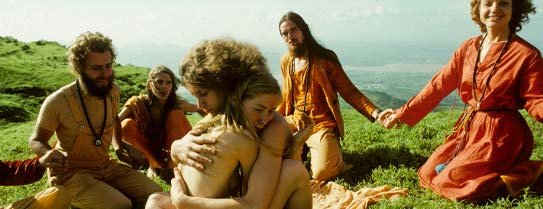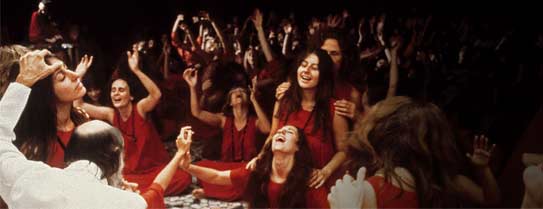
Synopsis
The wild Seventies. A quest for higher consciousness, spirituality and sexual freedom. In England, young Hugh Milne hears the voice of spiritual teacher Bhagwan Shree Rajneesh on an audiotape and travels to India in search of his own self. Sheela Patel, a young Indian woman, is brought to the charismatic guru by her father. At 21, she knows: all she wants is to be with this man.
In his Ashram in Poona, Bhagwan urges his disciples to meditate and practise tantric sex in order to reach a higher plane of consciousness. Hugh watches the guru's ascent as his bodyguard. Sheela becomes his secretary and the powerful boss of Bhagwan's model community born in the mountains of Oregon in the Eighties. 5000 young people aspire to build an ideal community as an example to the world. The guru, decried as "sex-guru" by the Western media in the 1970s, is now making headlines with his Rolls-Royces. The dream turns into a nightmare, for Hugh into a mental breakdown, for Sheela into a prison sentence. Where did it begin to go wrong?
«GURU – Bhagwan, His Secretary & His Bodyguard» – a spiritual journey into the depths and abysses of the human soul.

Crew
Production: Philip Delaquis, Das Kollektiv für audiovisuelle Werke GmbH
Written & Directed by: Sabine Gisiger and Beat Häner
Digital Strategist: Christopher Sauter
Directors of Photography: Beat Häner, Matthias Kälin
Sound Recordists: Saul Rouda, Martin Witz
Editing: Barbara Weber
Music: Marcel Vaid
Song: Raphelson
Sounddesign/Mix: Roman Bergamin

Director's Notes
Initially, what fascinated us most was the era of upheaval and this incredible story.
In the 1970s, thousands of young Westerners turned their backs on their old lives and searched for bliss in the Indian town of Poona, looking to reach a higher plane of consciousness with Bhagwan Shree Rajneesh. They wanted to leave their materialistic, bourgeois society behind, practise free sexuality and find their true selves. In the Eighties, they followed Bhagwan into the wilds of Oregon. They invested all their energy and enthusiasm into building an ideal community guided by love and spirituality. The dream of a peaceful model community ended in a society with totalitarian structures.
How is it possible that people rejecting social shackles and interested in self-realization end up living in a constrained and hierarchical community?
This is what our research revealed:
To this day, many former Neo-Sannyasins put the blame on Sheela Birnstiel, Bhagwan's secretary and boss of the Oregon commune. When it all collapsed, the guru made her into a scapegoat while he came out of it unscathed.
Why was there so little debate and self-questioning among the guru's disciples? So little questioning of personal responsibility and paranoia?
It was difficult to find former Sannyasins willing to participate in a film putting the emphasis on Sheela. Hugh Milne did not show such qualms. And yet Sheela, his mistress in Poona, had thrown him out of the commune. To this day, he is still asking himself the same question, which has now become part of the film's prologue: "Where did it begin to go wrong?“
When does it make sense to seek guidance with a guru, and to what extent can you give up your own responsibility? When does a guru become dangerous, if not simply negligent?
By the end of our research, we knew that we wanted to limit our film to Sheela and Hugh's experience, choosing depth over breadth. The secretary and the bodyguard: two archetypical characters from the centre of power, embedded in a story which goes beyond the history of the Neo-Sannyasins. We were particularly interested in the individual and collective mechanisms leading to totalitarian systems supposedly holding the truth and the light. What we wanted to avoid, however, was a cold, analytical film. We aimed to create an emotionally stirring piece, profound and close to its subjects. Both Sheela and Hugh trusted us. Both were prepared to relive their stories through day-long conversations in front of the camera and to answer our questions. These were emotionally draining days and we are deeply grateful to our two protagonists.
Searching through archives proved to be an adventure and we found a lot of unpublished footage, shown in this film for the first time. Over the three years it took to create this piece, we have watched many of the existing films about Bhagwan and the Neo-Sannyasin movement. We have noticed that depending on the author, they either give way to uncritical hero worship or spiteful condemnations. We were interested in a film which would be both analytical and moving, a voyage into the human soul and that of the audience. We also noticed that previous documentaries all mention sex on a purely superficial level in spite of its crucial role in Bhagwan's movement. In our film, we have devoted a lot of time and space to the Poona experiments. For we are all deeply affected by the relationship between body and soul and how we deal with love and sexuality.
Sabine Gisiger and Beat Häner, March 2010



